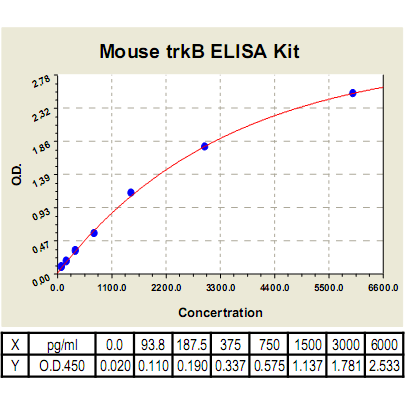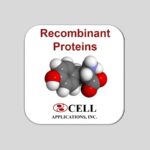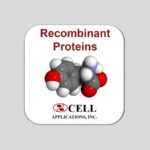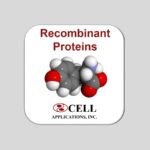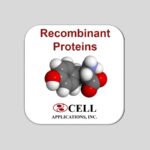TrkB ELISA Kit, Mouse
Mouse TrkB ELISA Kit: Mouse Tropomyosin Receptor Kinase B ELISA Kit
Size: 96 Wells
Price: $511.00
Description
TrkB, while binding its high affinity ligand brain-derived neurotrophic factor (BDNF), will play an essential role for nervous system development, neuronal survival, differentiation, and maintenance. Ligand binding to TrkB receptor causes receptor dimerization and the activation of the intrinsic tyrosine kinase domain of TrkB. The initial substrate of the TrkB kinase is the receptor itself, which results from tyrosine phosphorylation of the other subunit of TrkB dimer. A tyrosine-phosphorylated TrkB recruits, phosphorylates, and activates a variety of adapter molecules that initiate downstream signaling cascades. Phosphotyrosine residues of activated TrkB-receptors serve as specific recognition sites for effector molecules that contain a Src homology 2 domain. Among the proteins that interact with tyrosine-phosphorylated TrkB are the enzymes phospholipase Cgamma (PLCgamma) and phosphoinositol 3-kinase and the adapter protein Shc. Each of these molecules activates distinct signaling pathways that may have different functions. The Ras/mitogen-activated protein kinase (MAPK) pathway initiated by Shc or PLCgamma is involved in cell proliferation and differentiation, while the phosphoinositol 3-kinase pathway is important for survival.2
Furthermore, accumulating evidences implies that TrkB signal pathway may also be involved in a variety of human cancers, in which TrkB is likely to play a role in initiation and metastasis of carcinomas. Overexpression of TrkB is often correlated with the tumorigenesis, angiogenesis and drug resistance in these malignancies, contributing significantly to the metastasis and aggressive phenotype of these poor prognosis tumors. The evidences to show the significant contribution of TrkB to malignancy not only came from solid tumors such as neoblastoma, pancreas cancer, Wilm’s tumor and hepatocarcinoma, but also came from haematological malignancies such as Hodgkin lymphoma and multiple myeloma. Emerging data have suggested that TrkB may be a mediator as well as a marker of carcinogenesis and metastasis, therefore TrkB may be used as a valuable target for cancer therapy especially for the metastatic tumors with poor prognosis. The fact that TrkB is a receptor tyrosine kinase in principle allows various ways of targeted interference. Indeed, attempts are being made already to develop inhibitors of Trk kinase signaling. Preclinical xenograft studies suggest that such inhibitors can delay tumor growth.3
2. Guiton, M. et al: J. Biol. Chem. 270: 20384-90, 1995
3. Desmet, C.J.& Peeper, D.S.: Cell Mol Life Sci. 63:755-9, 2006
Details
| Cat.No.: | CL0849 |
| Target Protein Species: | Human |
| Range: | 93.8pg/ml-6000pg/ml |
| Specificity: | No detectable cross-reactivity with any other cytokine. |
| Storage: | Store at 4°C. Use within 6 months. |
